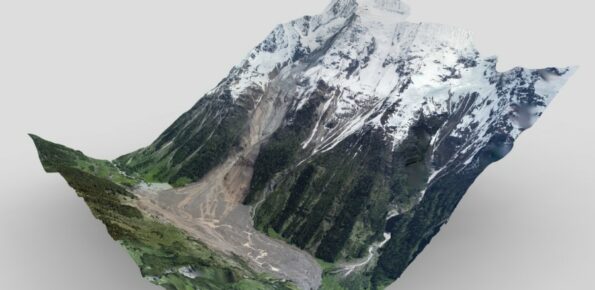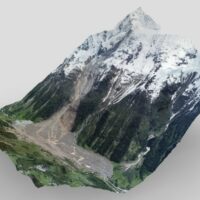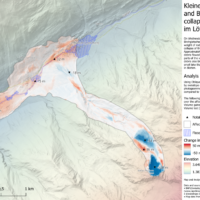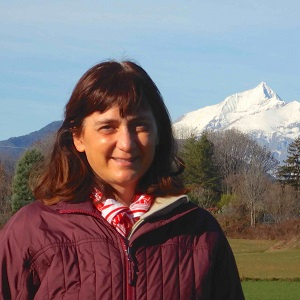The exceptional ice-rock avalanche of Blatten in Valais (CH)
An extraordinary event that questions the present and future natural hazards in the Alps in a context of global warming

On 28 May 2025, at15:24 (CEST), the frontal part of the Birch Glacier in Valais (CH), estimated at around 3 million m3, collapsed, dragging with it over 6 million m3 of debris that had accumulated on its surface over the previous weeks, following a sequence of rockfalls from the northern slope of the Kleines Nesthorn (3335 m a.s.l.). The ice mass disintegrated immediately after detachment, giving rise to a catastrophic ice-rock avalanche with a front of 500 m, which propagated along the slope at a speed of 200 km/h, all the way to the Lötschental valley floor. After a run of over 2.5 km and a drop of 1200 m, the avalanche runs up the opposite side of the valley for about half a kilometer and 240 m of elevation: the videos that filmed its arrival on the valley floor show a gigantic cloud that, in passing a rock step at an altitude of about 1850 m, becomes so jagged that it resembles the explosion of a firework. In an instant, the cloud of dust that accompanies the blow of the avalanche reaches the houses of Weissenried: the impact and the air blow caused by the avalanche are felt throughout the valley. The energy released by the moving mass is so high that a nearby seismic station detects an event of indicative magnitude 3.1. The mass of ice, rock, water and plant debris expands on the valley floor, occupying a 2.5 km stretch for a width of up to 900 m. Downstream, the flow stops abruptly at 1410 m a.s.l., just above the village of Wiler. Upstream, the flow goes up the valley for about one kilometer, burying the town of Blatten under a 20-30 m thick blanket of debris. The Lonza Torrent, on the valley bottom, is dammed by the massive accumulation of the avalanche and a temporary lake is formed, raising fears of a possible flood wave in the event of its sudden emptying: fortunately, after a couple of days the torrent manages to naturally open a path for drainage inside the deposit and the lake level stabilizes. The management of the emergency in Blatten was exemplary and represents a model of management of natural risks in complex environments such as glacial and periglacial areas, in a period of rapid transformations due to ongoing climate change. In the face of one of the most catastrophic events that have involved inhabited areas in the Alps, the toll is of only one person missing: the 300 inhabitants of Blatten, in fact, were removed from their homes at the onset of the first warning signs of what could happen. The early warning was possible thanks to the fact that the Birch Glacier had been under observation for over two decades, following two large ice avalanches that had reached the valley floor in the 1990s, and had already been showing an anomalous advance for several years. Constant monitoring made it possible to identify the onset of a critical phase on the northern side of the Kleines Nesthorn, subject to a sequence of collapses, including some large ones (the largest on 19 May, estimated at around 300,000 m3). Following the water overpressures created in the glacier mass due to the load of debris on the surface and the water contributions from snow-glacial melt and rainfall, the frontal sector of the glacier, hanging on a rocky step at around 2600 m, began to accelerate (reaching speeds of 10 m/day) and to generate small ice failures. All these signs of instability were correctly interpreted and communicated to the inhabitants of Blatten, who abandoned the area.
Although detailed analyses are still ongoing, all the ingredients of the effects of ongoing global warming can be recognized in what happened: a slope that has undergone significant deglaciation in recent decades, a rock face with a northern aspect and characterized by degrading permafrost, a glacier with abundant en/subglacial water circulation. Although the data available on this type of event is too limited to be able to outline statistically based trends, it is clear that the Blatten event does not represent an isolated case, but is part of a sequence of events that in the last two-three decades have dotted the high mountains in the Alps and in other parts of the planet. For example, we can mention the ice and rock avalanche in the Brenva basin (Mont Blanc) on 18 January 1997 and those of 2007, 2010, 2015 and 2024 on the east face of Monte Rosa. In Switzerland, the rock and ice avalanche of Pizzo Cengalo (Val Bondasca) on 23 August 2017 had great resonance, which triggered a massive debris flow, in the total absence of precipitation, that reached the village of Bondo. In Asia, the consequences of the Kolka-Karmadon rock and ice avalanche on 20 September 2002 (Caucasus) and that of Chamoli (India) on 7 February 2021 were dramatic.
In order to be able to apply correct prevention and mitigation measures of natural hazards, in the coming years it will be of vital importance to intensify studies on the natural instability processes taking place in high-altitude environments. These studies concern in particular the evolution of glacial masses, the cryosphere and permafrost, which must be conducted through the acquisition of data on the ground and satellite data, in order to promptly recognize the onset of critical situations and appropriately follow their evolution. Another important action to be undertaken in order to contribute to the development of knowledge on these issues is to give increasing importance to historical documentation, and to the creation and updating of inventories relating to these processes. A correct information on the hazards associated with glaciers and permafrost will also be central, aimed at those who live and frequent the mountains. In this regard, Alpine huts and observatories represent a privileged place for communication and dissemination.
To know more
ETH, “Fact sheet for the now-collapsed Birchgletscher, Switzerland: https://polybox.ethz.ch/index.php/s/eazXqWn8z6rPNwo
Simeon Schmauß, “3D model”: https://sketchfab.com/3d-models/blatten-glacier-collapse-2025-05-30-037bb8933d2444d6b283da885ab77a8d





 Contact person: marta chiarle -
Contact person: marta chiarle -